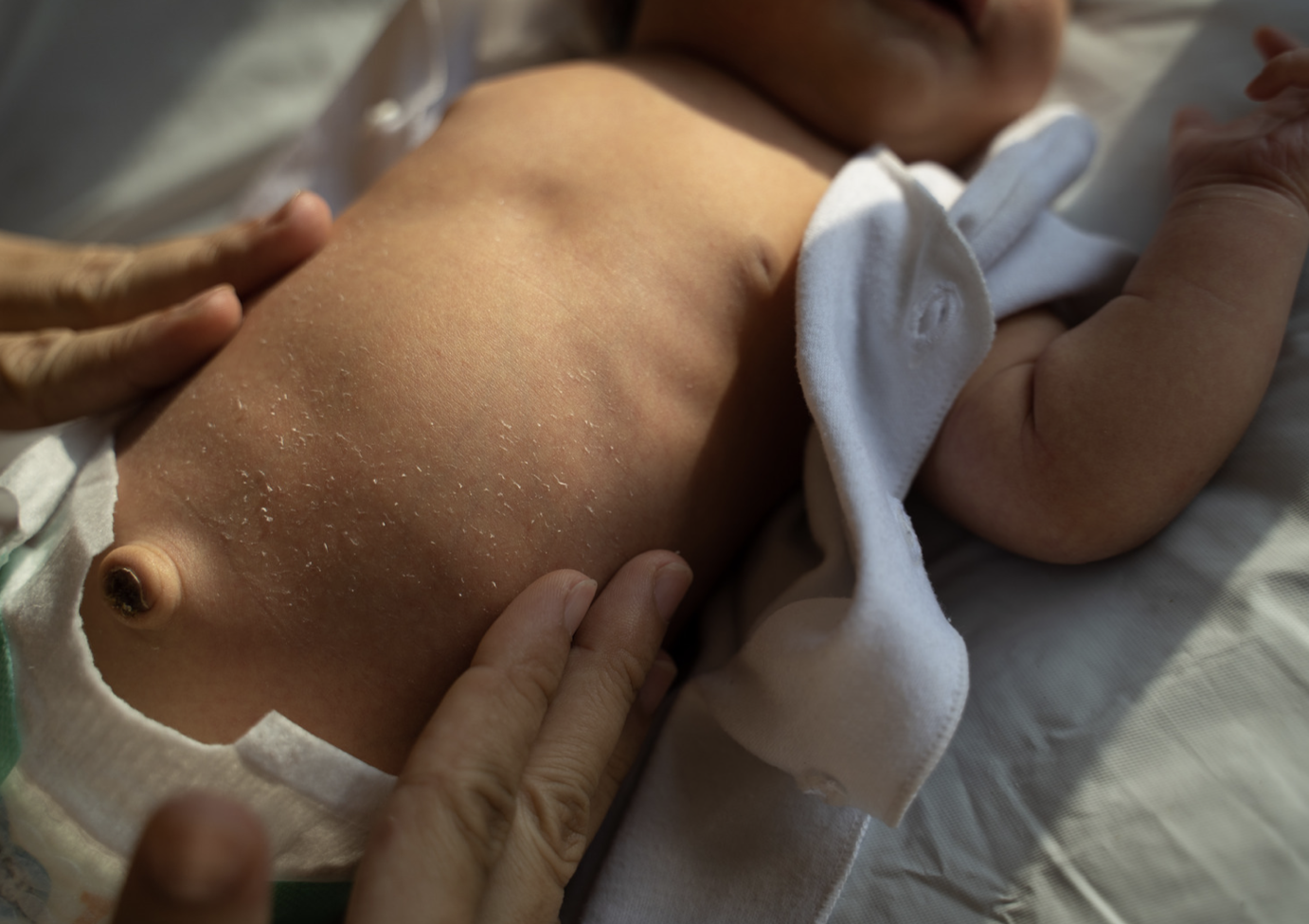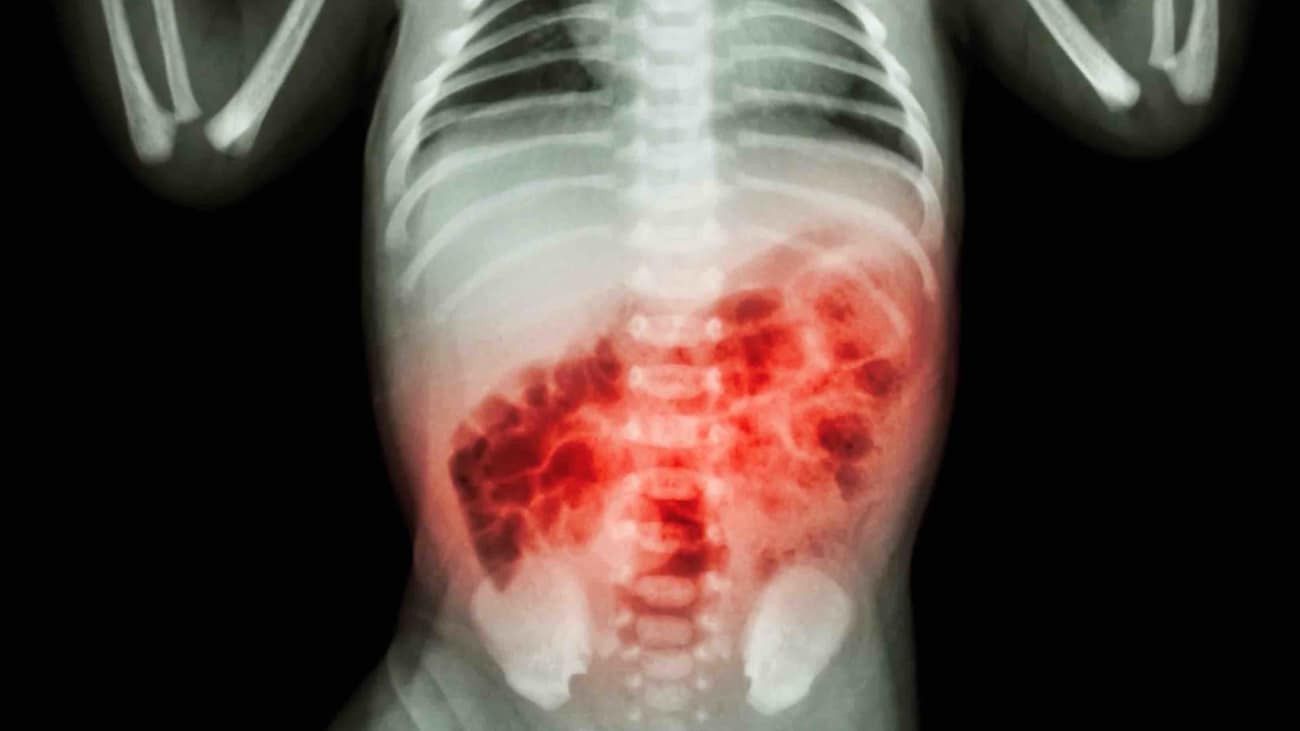Definisi
Intususepsi adalah keadaan di mana sebagian dari usus terlipat ke dalam bagian usus lain disekitarnya, membuat usus berbentuk seperti teleskop. Keadaan ini adalah keadaan gawat darurat karena usus yang terlipat dapat menyebabkan gangguan dalam pergerakan makanan dan aliran darah. Jika lipatan tidak segera dibebaskan maka usus dapat berlubang dan gangguan aliran darah yang terjadi dapat menyebabkan kematian sebagian jaringan usus. Intususepsi dapat memburuk dalam waktu 2-5 hari. Intususepsi sering terjadi pada bayi, terutama yang memiliki riwayat infeksi saluran napas atas. Kenali tanda dan penyebab dari intususepsi melalui artikel dibawah ini!
Penyebab
Sebagian besar kasus intususepsi (90%) tidak memiliki penyebab yang khusus dan terjadi secara spontan. Beberapa hal yang diketahui bisa menyebabkan intususepsi, meliputi:
- Infeksi
- Kelainan anatomi atau kelainan bentuk usus
- Adanya perubahan pada pergerakan usus
- Divertikulum Meckel: kelainan bawaan sejak lahir berupa kantung kecil yang terbentuk di usus halus
- Polip usus
- Radang usus buntu
- Adanya pembengkakan pada Peyer’s Patch (Bagian usus yang berfungsi sebagai organ yang menghasilkan imun di usus)
- Idiopatik (tidak diketahui penyebabnya)
Faktor Risiko
Faktor risiko paling besar bagi seorang bayi untuk mengalami intususepsi adalah memiliki riwayat infeksi gastroenteritis atau diare akut. Pada saat mengalami infeksi, jaringan limfe yang melapisi usus dapat bengkak dan membuat bagian usus saling menarik satu sama lain. Intususepsi lebih sering terjadi pada anak laki-laki dibandingkan dengan perempuan dan lebih sering terjadi pada anak-anak dibandingkan dengan orang dewasa. Selain itu faktor risiko lain adalah:
- Kelainan bentuk pada usus
- Mempunyai riwayat penyakit lain seperti fibrosis kistik, kelainan autoimun Henoch-Schonlein Purpura, penyakit Crohn dan Celiac
Gejala
Bayi dengan kecurigaan ke arah intususepsi dapat mengalami gejala seperti:
- Muntah: pada awalnya muntah dapat berupa cairan bening, namun saat sudah terjadi penyumbatan usus, muntah dapat berwarna kehijauan
- Nyeri perut dengan karakteristik nyeri berat dan hilang timbul
- Perubahan konsistensi dari tinja, dapat mengandung darah atau lendir seperti bentuk jelly
- Tampak lemas sepanjang hari
- Terdapat massa atau bagian perut yang keras
- Bayi akan rewel karena merasakan nyeri
- Tumor: sering ditemui pada orang dewasa
Gejala intususepsi pada orang dewasa memiliki gejala yang berbeda dan seringkali memiliki gejala yang mirip dengan penyakit lain. Gejala yang sering timbul pada orang dewasa dengan intususepsi adalah adanya nyeri perut yang hilang timbul, disertai dengan rasa mual dan muntah. Keluhan dapat berlangsung selama berminggu-minggu sebelum nyeri menjadi tidak tertahankan.
Diagnosis
Pada pertemuan pertama dengan dokter, Anda akan menerima pertanyaan terkait riwayat kesehatan pasien seperti:
- Kapan gejala nyeri perut dimulai?
- Apakah nyeri perut terjadi terus menerus atau hilang timbul?
- Apakah nyeri berhenti secara tiba-tiba?
- Apakah ada gejala lain seperti mual, muntah atau diare?
- Apakah ada yang berbeda dari konsistensi tinja? Seperti berdarah atau berlendir?
- Apakah tampak benjolan pada perut?
Pada pemeriksaan fisik bayi dengan intususepsi, terdapat tanda yang khas yaitu dance sign. Terdapat massa berbentuk seperti sosis di bagian kanan atas dan adanya bagian perut yang kosong di kanan bawah. Benjolan akan lebih gampang untuk diraba pada saat perut sedang kontraksi. Jika pemeriksaan fisik tidak memberikan gambaran yang jelas, maka pemeriksaan tambahan yang dapat dilakukan oleh dokter adalah:
- Pemeriksaan radiologi: Menggunakan x-ray abdominal tanpa kontras. Pada 60% kasus, penggunaan x-ray dapat mendiagnosa intususepsi
- Ultrasonografi (USG): Pada pemeriksaan USG, dokter akan memeriksa lapisan usus, jika terdapat intususepsi terdapat tanda yang khas yaitu usus yang akan memberikan gambaran papan target dan tanda pseudokidney
- Kontras enema: Tindakan memasukkan cairan enema merupakan tindakan yang bersifat mengobati dan mendiagnosa dalam waktu yang bersamaan
Tata Laksana
Salah satu metode yang dipilih untuk mengobati usus yang terlipat adalah dengan menggunakan barium enema. Penggunaan enema untuk pengobatan merupakan terapi yang sudah dilakukan sejak lama. Pada pengobatan barium enema, dokter akan memasukkan selang kecil melalui anus ke dalam usus besar, kemudian untuk membebaskan lipatan usus, terdapat dua pilihan zat yang dapat dimasukkan melalui selang yaitu cairan atau udara. Tindakan ini tidak selalu berhasil, dan pada beberapa kasus anak membutuhkan tindakan operasi untuk membebaskan lipatan usus.
Tindakan operasi pada bayi dengan intususepsi adalah dengan tindakan manual untuk membebaskan lipatan. Namun, apabila ternyata sudah terjadi komplikasi seperti adanya bolongan pada lapisan usus, maka, diperlukan pengangkatan bagian usus yang sudah mati. Pilihan terapi bergantung dari tingkat keparahan dan pertimbangan dari dokter.
Setelah pasien menerima tindakan, pasien baru diperbolehkan pulang dari rumah sakit jika sudah dapat mengkonsumsi makanan seperti biasa, tidak mengalami demam dan tidak ada cairan yang keluar dari bekas luka operasi. Kemudian dokter akan menilai pergerakan usus pasien apakah sudah kembali normal. Setelah pulang, pasien masih membutuhkan istirahat untuk beberapa hari. Pasien baru diperbolehkan untuk melakukan olahraga atau kegiatan berat 3-4 minggu pasca operasi. Dokter biasanya akan menjadwalkan jadwal kontrol pasca operasi seminggu dan empat minggu pasca operasi.
Pada beberapa kasus intususepsi, lipatan dapat hilang dengan sendirinya tanpa pengobatan.
Komplikasi
Komplikasi paling serius dari intususepsi adalah lubang di lapisan usus (perforasi). Saat aliran darah ke usus terganggu, hal ini dapat membuat bagian dari usus mati. Saat lapisan usus mati, jaringan dapat lebih rentan mengalami robekan dan membuat isi dari usus keluar ke rongga perut. Isi dari usus dapat menyebabkan infeksi dinding perut (peritonitis). Peritonitis adalah keadaan gawat darurat yang membutuhkan penanganan medis segera.
Pencegahan
Karena sebagian besar kasus terjadi secara spontan, hingga saat ini tidak diketahui cara pasti untuk mencegah intususepsi. Namun beberapa hal yang dapat anda lakukan untuk mencegah komplikasi dari usus yang terlipat adalah:
- Mengawasi tanda-tanda bahaya dari anak dengan nyeri perut, terutama jika nyeri perut berlangsung untuk waktu yang lama
- Segera pergi ke fasilitas kesehatan terdekat jika mengalami nyeri perut hebat yang hilang timbul dan tidak diketahui penyebabnya
- Melakukan kontrol rutin ke dokter jika memiliki riwayat penyakit kronis seperti penyakit autoimun yang membuat seseorang beresiko mengalami intususepsi
Kapan Harus ke Dokter?
Nyeri perut (abdomen) yang berlangsung untuk waktu yang lama sering kali berbahaya dan dapat terjadi perburukan dalam waktu yang cepat. Salah satu komplikasi dari intususepsi yang harus diwaspadai adalah terjadinya peritonitis. Gejala peritonitis yang dapat anda lihat dari anak atau orang terdekat anda adalah:
- Nyeri perut disertai dengan pembengkakan perut
- Demam dan adanya muntah berulang
- Kulit yang pucat dan keringat dingin, pada keadaan ini pasien memiliki kemungkinan besar dalam keadaan syok
- Denyut nadi yang lemah dan cepat
- Pola pernafasan yang cepat dan dangkal
- Tampak gelisah
Mau tahu informasi seputar penyakit lainnya? Cek di sini, ya!
- dr Ayu Munawaroh, MKK
- Intussusception, diagnosis, and treatment—Mayo Clinic. Mayoclinic.org. (2022).
- Intussusception (Bowel Obstruction): Treatment & Symptoms. Cleveland Clinic. (2022).
- Chahine, A., & Cuffari, C. (2022). Intussusception: Practice Essentials, Background, Etiology, and Pathophysiology. Emedicine.medscape.com.
- Cassas-Melley, A. (2022). Intussusception (for Parents): Nemours KidsHealth. Kidshealth.org.
- Jain, S., & Haydel, M. (2022). Child Intussusception. Ncbi.nlm.nih.gov.
- Clinical Practice Guidelines: Intussusception. Rch.org.au. (2019).
- Therapeutic Enema for Intussusception. Radiologyinfo.org. (2020).
- Meckel’s Diverticulum: Causes, Symptoms, Diagnosis, & Treatment. Cleveland Clinic. (2020).












